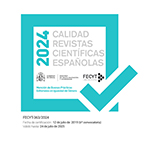Mercantilización de los cuerpos de las mujeres en los medios de comunicación para jóvenes rebeldes: el “capital de la transgresión”
Resumen
Resumen. Introducción. Este artículo aborda el papel de los medios de comunicación como agentes normalizadores de la mercantilización de las mujeres en sociedades formalmente igualitarias, en concreto de aquellos medios dirigidos a jóvenes y que definen sus líneas editoriales como transgresoras. Así mismo, se estudiará el propio valor simbólico de esta “transgresión” como capital de las cabeceras de estos medios y de su imagen de marca. Objetivos. En primer lugar, analizar el papel de los medios en la construcción y difusión de las “identidades rebeldes” que consume la juventud. En segundo lugar, concretar los discursos por las que esta audiencia interioriza la pornografía y la prostitución como prácticas subversivas y disidentes. Metodología. A través de un enfoque interdisciplinar, el texto efectúa una revisión del proceso de resignificación del término “feminismo” en “posfeminismo” como eje vertebrador de la investigación. En una segunda parte, se realiza una aproximación conceptual a la “filosofía de la transgresión”, como fundamento legitimador de los discursos posfeministas. Como trabajo de campo, se han seleccionado tres revistas, Vice Magazine, PlayGround y Teen Vogue, representativas por su elevado número de seguidores y por sus publicaciones frecuentes de contenidos favorables a la mercantilización de las mujeres como forma de empoderamiento femenino. Conclusiones. Esta investigación concluye, por un lado, que la “transgresión” representa un capital simbólico clave en la venta de contenidos a jóvenes. Por otro, que la transgresión mediática es, en realidad, una representación de la transgresión integrada en los valores del sistema y acorde a la titularidad y a los intereses privados de los medios que la reproducen. Para lograr esta simulación, se utilizan discursos evocadores de la lucha social y la retórica de la disidencia sexual que, como se expone, carecen de un análisis profundo de opresión de género o clase.
Descargas
Descarga artículo
Licencia
La revista Investigaciones Feministas, para fomentar el intercambio global del conocimiento, facilita el acceso sin restricciones a sus contenidos desde el momento de su publicación en la presente edición electrónica, y por eso es una revista de acceso abierto. Los originales publicados en esta revista son propiedad de la Universidad Complutense de Madrid y es obligatorio citar su procedencia en cualquier reproducción total o parcial. Todos los contenidos se distribuyen bajo una licencia de uso y distribución Creative Commons Reconocimiento 4.0 (CC BY 4.0). Esta circunstancia ha de hacerse constar expresamente de esta forma cuando sea necesario. Puede consultar la versión informativa y el texto legal de la licencia.











